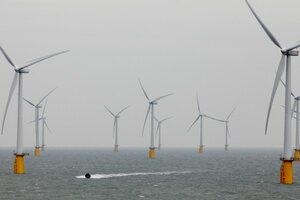US to sell offshore wind leases
Federal plans to sell competitive leases next year for offshore wind farms off Massachusetts, Rhode Island, and Virginia are a first. Each offshore wind farm could power 700,000 homes.

A small boat passes through the windmills of the Thanet Offshore Wind Farm off the coast of Ramsgate in Kent, England, in this 2010 file photo. The US Interior Department announced Nov. 30, 2012, that it would sell competitive leases for two offshore wind farms: one off the Massachusetts/Rhode Island coast and the other off the Virginia coastline.
Gareth Fuller/PA/AP/File
PROVIDENCE, R.I.
The federal government plans to sell leases for wind farms off the coasts of Rhode Island, Massachusetts and Virginia, marking the first time it has sold competitive leases for wind energy on the outer continental shelf, officials said Friday.
The leases for the two areas, which total more than 430 square miles, will be sold next year, the Department of Interior and its Bureau of Ocean Energy Management said.
"Wind energy along the Atlantic holds enormous potential, and today we are moving closer to tapping into this massive domestic energy resource to create jobs, increase our energy security and strengthen our nation's competitiveness in this new energy frontier," Interior Secretary Ken Salazar said in a written statement.
The announcement was hailed by the conservation group Oceana, which called it a major step in developing domestic clean energy.
"We're getting a step closer to seeing real turbines out there in the water," said Nancy Sopko, the group's ocean advocate. "The more progress is made, it sends that signal out to the rest of the world that the U.S. is serious about developing wind energy here."
The zone off Rhode Island and Massachusetts, which sits a little about 10 miles off Rhode Island's shore, will be leased in two parcels. The Virginia area, about 27 miles off the southern part of the state, will be available as a single lease, the Department of Interior said. Officials said each area could be developed to generate enough electricity to power 700,000 homes.
The plan is part of an Obama administration strategy to focus energy development in areas with the greatest potential and to work with states, commercial fishermen and other stakeholders early in the process to address possible conflicts, said Tommy P. Beaudreau, director of the Bureau of Ocean Energy Management.
There are no offshore wind farms in the United States, although several are already in development off Massachusetts, Rhode Island, New Jersey and Delaware. The Rhode Island and New Jersey developments are in state waters, while the Delaware lease was not awarded in a competitive process, Sopko said.
The Cape Wind project, in federal waters off Cape Cod in Massachusetts, was the nation's first offshore wind project to be approved and predates the system that has since been put into place, Sopko said. It is scheduled to be up and running in 2015.
A project under development in Rhode Island, which includes just a handful of turbines, is scheduled to go online in 2014, which is would make it the nation's first offshore wind farm.

